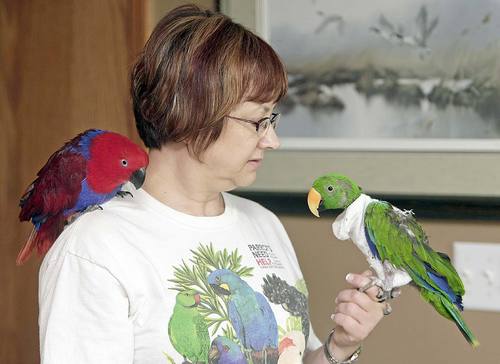The parrot trap: Fargo empty nesters fill home with flock of birds
 Tuesday, May 24, 2011 at 6:13
Tuesday, May 24, 2011 at 6:13  Brenda Topley talks to pet parrots Scarlet, left, and Sherlock. Sherlock wears a sock over his chest to deter his feather-plucking habit. David Samson / The ForumFargo – As Stuart and Brenda Topley’s children left home for college, the couple began feathering their emptying nest – literally. Six colorful, vocal parrots now reside in their Rose Creek home.
Brenda Topley talks to pet parrots Scarlet, left, and Sherlock. Sherlock wears a sock over his chest to deter his feather-plucking habit. David Samson / The ForumFargo – As Stuart and Brenda Topley’s children left home for college, the couple began feathering their emptying nest – literally. Six colorful, vocal parrots now reside in their Rose Creek home.
Brenda says it happened coincidentally, but “it sure kept us busy.
“Growing up, my brother had asthma, so we never had a cat or a dog,” Brenda says. “And I’ve always liked outdoor birds, same with my husband.”
“Their intelligence really amazes me,” Brenda adds.
The six parrots each have personalities akin to human offspring. There’s Scarlet, as hormonal and moody as a teenager, and happy-go-lucky Curly, content with just a wine cork to chew on. Sherlock is docile. Kiki can’t be trusted out of the cage. Einstein is talkative, and a little too smart for her own good.
And then there’s Churchill, nicknamed Big Bird, as mischievous and cuddly as a toddler, but by far the biggest and most powerful of the bunch. He can easily crack a Brazil nut in his beak. Once, when spooked, he crushed Brenda’s wedding ring. It had to be cut off her finger and was damaged beyond repair.
The family refers to him as a “gentle giant.”
“He’ll play peek-a-boo under a blanket or roll over and have you scratch his tummy like a dog,” Stuart says.
Churchill is a Hyacinth macaw, an endangered species, and a near-twin to Blu, the lead character in this year’s animated film “Rio.” Brenda says she enjoyed the movie because of its similarities to her family (Blu couldn’t fly and lived in the small, cold town of Moose Lake, Minn.), as well as the humorous nuances it portrays accurately, down to the way macaws walk.
But Brenda says she worries people who see the movie will want to go out and get a bird, not realizing the commitment involved. Macaws like Churchill are not easy or cheap to come by. The Topleys were on a waiting list for months. And he could live 80 to 100 years. The family had to prove someone would continue to care for the bird.
“My brother gets willed the big-screen TV, and I get the birds,” says Erin Topley, 27, the oldest of Stuart and Brenda’s three children. She’s the reason the Topleys got their first bird, Kiki, a pet for an advanced-placement science class her junior year of high school.
Many birds end up being rescued because they outlive their owner or because people don’t realize the care involved, Brenda says. Since getting their six birds, including one through adoption, she and Stuart have joined the Center for Avian Adoption, Rescue, and Education, a Fargo-based parrot rescue group.
“People think parrots will just talk and entertain you. They are a lot of work, and they are a lot of money to keep,” Brenda says.
Each morning, the Topleys awake to the sound of the six birds calling to their flock. It can be deafening at times, Erin says. “When the birds are screaming, Einstein will usually yell out ‘Quiet’ in my husband’s voice,” Brenda says.
Other times while visiting her parents, Erin says she’s woken to the sound of them quarreling at 6 a.m. Except it isn’t Stuart and Brenda, just Einstein doing spot-on impersonations.
The birds need to be fed breakfast and supper daily. Their diet consists largely of fresh fruit and vegetables and organic seeds, nuts and grains. “I think they eat better than us,” Brenda says.
The parrots should be preened daily and drenched in the shower once a week. Anytime the couple go on a trip, they need to hire a bird-sitter.
“This was our living room,” Brenda says, motioning to their home’s front room now lined with six metal bird cages. Tree perches fill the corners of their television room, and there’s an outdoor aviary in their backyard. Images of all sorts of birds decorate the house.
Brenda, a Fargo teacher, uses the birds in her work with elementary students. They can prompt lessons on endangered animals, science, art and writing. Children will write letters to a bird, and she responds in the bird’s voice, attaching a feather to the note.
Each bird has a car seat carrier to be transported to the schools, though Churchill has broken out of his several times.
Brenda points out the wood trim on the wall that Churchill dismantled with his beak. As he gnaws on a dining room chair or scales the kitchen cabinet drawers to get on the counter, she sternly reprimands him, though she admits the furniture is old, the house is “lived in.”
After all, the place has gone to the birds.
“They’re a lot of work, but they’re worth it,” Brenda says.

